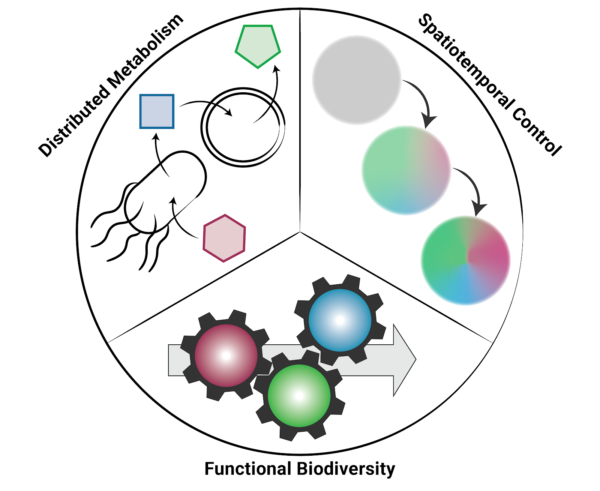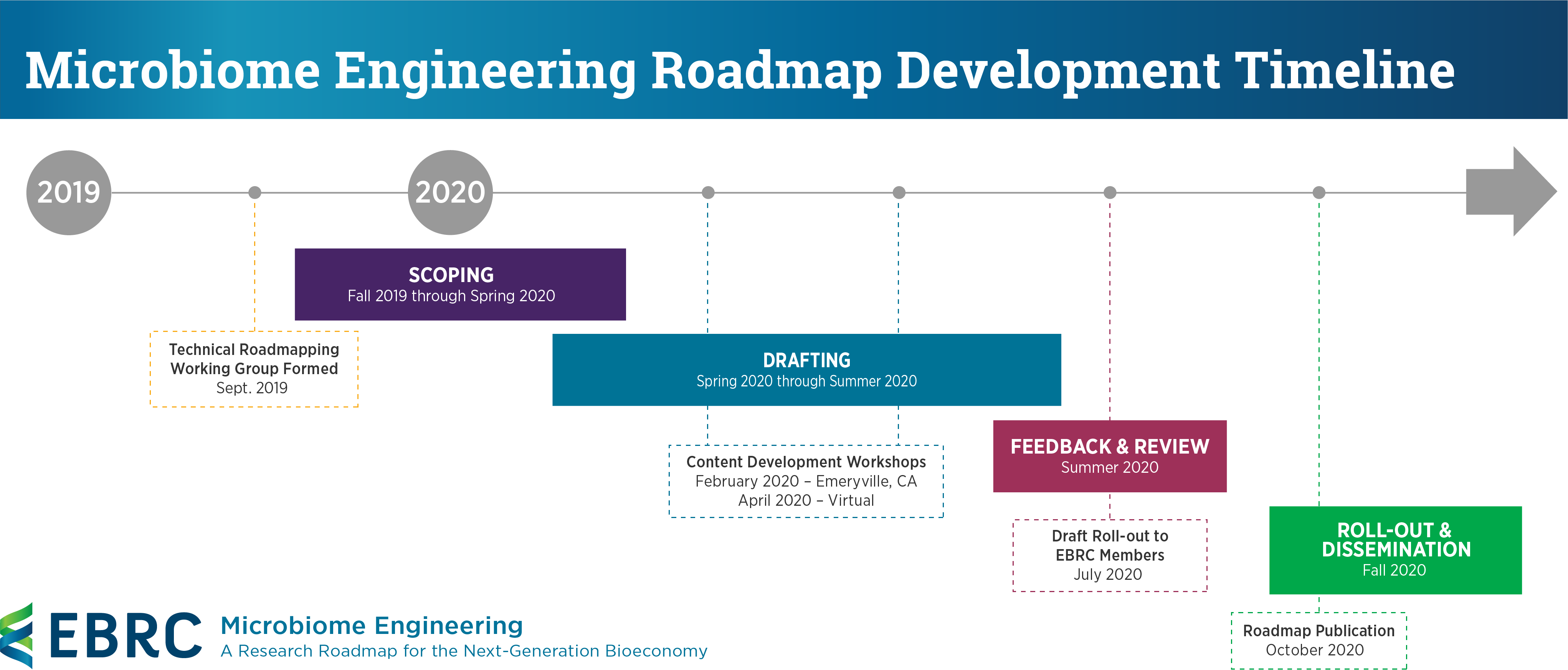Microbiomes, or communities of diverse microbes, are ubiquitous in nature and can be found on or in nearly every environment on Earth. Thousands of species of microbes live in the human gut where they help break down food, help train our immune system, and contribute to health in ways that are still not fully understood. They form communities everywhere humans have looked, from hot springs, to glaciers, to the deep ocean. Studies on microbiomes have been ongoing for the past two decades as their impacts on the world have been recognized. Large scientific initiatives like the Human Microbiome Project1The NIH HMP Working Group, Peterson, J., Garges, S., Giovanni, M., McInnes, P., Wang, L., Schloss, J. A., Bonazzi, V., McEwen, J. E., Wetterstrand, K. A., Deal, C., Baker, C. C., Di Francesco, V., Howcroft, T. K., Karp, R. W., Lunsford, R. D., Wellington, C. R., Belachew, T., Wright, M., … Guyer, M. (2009). The NIH Human Microbiome Project. Genome Research, 19(12), 2317–2323. View Publication sought to document the diversity of human microbiomes, leveraging new advances in DNA sequencing to observe how the microbiome changes from person-to-person and from location-to-location on the body.2Proctor, L. M. (2011). The Human Microbiome Project in 2011 and Beyond. Cell Host & Microbe, 10(4), 287–291. View Publication,3Turnbaugh, P. J., Ley, R. E., Hamady, M., Fraser-Liggett, C. M., Knight, R., & Gordon, J. I. (2007) The Human Microbiome Project. Nature, 449(7164), 804–810. View Publication However, even though microbiomes are now recognized to have important functions in many different environments,4Eisenstein, M. (2020). The hunt for a healthy microbiome. Nature, 577(7792), S6–S8. https://doi.org/10.1038/d41586-020-00193-3,5Jansson, J. K., & Hofmockel, K. S. (2018). The soil microbiome—From metagenomics to metaphenomics. Current Opinion in Microbiology, 43, 162–168. View Publication most research on microbiomes to date has been limited to correlative conclusions rather than mechanistic insights.
Advancing past correlations to a point where different genetic, proteomic, or metabolic processes can be intentionally altered to induce specific microbiome functions will require more fine-tuned control over a microbiome. Over the past decade, scientists have built some tools to facilitate the creation of artificial microbiomes or to help manipulate natural microbiomes.6Foo, J. L., Ling, H., Lee, Y. S., & Chang, M. W. (2017). Microbiome engineering: Current applications and its future. Biotechnology Journal, 12(3), 1600099. View Publication,7Pham, H. L., Ho, C. L., Wong, A., Lee, Y. S., & Chang, M. W. (2017). Applying the design-build-test paradigm in microbiome engineering. Current Opinion in Biotechnology, 48, 85–93. View Publication As these tools become more reliable, more specific, and higher-throughput, they enable a more mechanistic understanding of natural microbiome function, and make engineering new functions a feasible goal. However, continued advancements will still be needed, from additional tools like programmable bacteriocins and antimicrobial peptides,8Inda, M. E., Broset, E., Lu, T. K., & de la Fuente-Nunez, C. (2019). Emerging Frontiers in Microbiome Engineering. Trends in Immunology, 40(10), 952–973. View Publication to greater coordination of frameworks used to study microbiomes.9Lawson, C. E., Harcombe, W. R., Hatzenpichler, R., Lindemann, S. R., Löffler, F. E., O’Malley, M. A., García Martín, H., Pfleger, B. F., Raskin, L., Venturelli, O. S., Weissbrodt, D. G., Noguera, D. R., & McMahon, K. D. (2019). Common principles and best practices for engineering microbiomes. Nature Reviews Microbiology, 17(12), 725–741. View Publication Microbiome Engineering aims to provide a forward-looking examination of both the short- and long-term needs for microbiome engineering, to help scientists and policymakers fully utilize microbiome engineering.
About the Roadmap
The EBRC roadmap Microbiome Engineering: A Research Roadmap for the Next-Generation Bioeconomy is a critical assessment of the current state of microbiome engineering and areas of anticipated research and development in the next twenty years. It also details how those scientific advancements can be applied across different industry sectors. This roadmap aims to serve as a “go-to” resource for scientists working to engineer microbiomes, as well as policymakers interested in advancing microbiome engineering. Microbiome Engineering examines technical progress needed to advance microbiome engineering (Technical Themes) and details how these advances can be used to develop engineered microbiomes for specific applications (Application Sectors).
The roadmap is comprised of three Technical Themes: Spatiotemporal Control, Functional Biodiversity, and Distributed Metabolism. Spatiotemporal Control considers how to engineer microbiomes for precise, predictable position and function in space and over time. Functional Biodiversity discusses how to engineer microbiomes based on functionally similar, but taxonomically diverse, collections of organisms to increase the interoperability of engineered microbiomes in different environments. Finally, Distributed Metabolism focuses on designing microbiomes that leverage the unique metabolic capabilities of individual microbial species or taxa to collectively produce and/or degrade specific compounds.

Technical Themes for Microbiome Engineering. The roadmap examines the future of microbiome engineering in the context of three different technical themes. Each theme addresses a different, broad aspect of microbiome engineering that will need to be advanced to fully realize the potential of engineered microbiomes. Spatiotemporal Control discusses the advancements needed to control where cells and species localize in a microbiome over time, Functional Biodiversity explores how functional redundancy can be engineered using diverse, genetically unrelated organisms to contribute greater stability in the microbiome as conditions change, and Distributed Metabolism details how to engineer chemical transformations across multiple organisms in a microbiome.
Each of the three technical themes is built around Breakthrough Capabilities that will significantly advance microbiome engineering. The Breakthrough Capabilities are further divided into a stepwise path of research milestones anticipated to be reached by 2022, 2025, 2030, and 2040 (2-, 5-, 10-, and 20-years into the future, respectively). The shorter-term milestones for 2022 and 2025 are intended to be achievable with existing programs, infrastructure, and facilities. The longer-term 2030 and 2040 milestones may require significant investments, technically, financially, or otherwise, but will substantially advance microbiome engineering.
During the roadmapping process we identified several technical challenges that were broadly applicable and would be necessary for advancing all three Technical Themes. These challenges were captured under Transformative Tools & Technologies and will be some of the most critical areas of research for advancing microbiome engineering. In particular, substantial efforts will be needed to help advance microbiome models, cellular signaling and communication, and computational methods for predicting microbiome design, growth, and function.
The Application Sectors are derived from Engineering Biology: A Research Roadmap for the Next Generation Bioeconomy10Engineering Biology Research Consortium. (2019). Engineering Biology: A Research Roadmap for the Next-Generation Bioeconomy. View Publication: Industrial Biotechnology, Health & Medicine, Food & Agriculture, Environmental Biotechnology, and Energy. Within each Sector we examine how advancements in microbiome engineering can help address several broad societal challenges. The societal challenges in Microbiome Engineering partially overlap with those in Engineering Biology, but some were revised to more effectively capture microbiome engineering research. Specific technical achievements are identified that would contribute to solving these societal challenges, demonstrating the diverse potential applications of microbiome engineering. Individual species of engineered microbes have been used in many of these sectors already, but developing microbiomes for similar applications will help decrease costs, expand functionality, and enable greater accessibility and usability. In some cases, microbiome engineering will also enable completely new functions that are not feasible with a single microbe. As a result, developments in microbiome engineering will have both short-term impacts on applications of existing technologies and more transformative long-term impacts on humans’ interactions with the microbial world.
Read our ACS Synthetic Biology Viewpoint on the opportunities presented in this roadmap: Engineering Microbiomes — Looking Ahead (published December 18, 2020).
This material is based upon work supported by the National Science Foundation under Grant No. 1818248.
EBRC recommends the following citation when referencing the Roadmap:
Engineering Biology Research Consortium (2020). Microbiome Engineering: A Research Roadmap for the Next-Generation Bioeconomy. Retrieved from http://roadmap.ebrc.org. doi: 10.25498/E4QP4T.
Societal Considerations and Integrating Public Values
The challenges and achievements presented in EBRC’s roadmaps do not occur in a vacuum. Advancing engineering biology will require significant parallel, non-technical efforts to address societal, legal, and regulatory challenges. In this section, we examine some of the broader considerations that need to be addressed to ensure that new technologies work in the best interests of society. Learn More
Project Development
Microbiome Engineering: A Research Roadmap for the Next-Generation Bioeconomy is a follow-up to the 2019 EBRC Roadmap Engineering Biology: A Research Roadmap for the Next-Generation Bioeconomy. It further elaborates on the role of engineering biology for microbial biomes and consortia. The topic was covered briefly in Engineering Biology, but many members of the engineering biology community recognized that microbiome engineering presents unique technical challenges and potential applications to warrant a more in-depth examination.
Over the course of late 2019 and the first half of 2020, the EBRC Technical Roadmapping Working Group helped develop the framework and content of this roadmap. Our work over conference calls was intended to be supplemented by several in-person workshops, but in the wake of the SARS-CoV-2/COVID-19 pandemic we were forced to adjust and adapt. Instead, this roadmap is the product of a two-day writing workshop, supplemented with countless Zoom calls and Slack messages during the spring and summer of 2020. Over forty faculty, industry experts, postdoctoral scholars, and graduate students all contributed their expertise to this roadmap, and this roadmap would not have been possible without them. We intend for this roadmap to provide a comprehensive look into the current state of microbiome engineering and help set long-term goals to advance the field.

Footnotes & Citations
- Engineering Biology Research Consortium. (2019). Engineering Biology: A Research Roadmap for the Next-Generation Bioeconomy. https://doi.org/10.25498/E4159B
- The NIH HMP Working Group, Peterson, J., Garges, S., Giovanni, M., McInnes, P., Wang, L., Schloss, J. A., Bonazzi, V., McEwen, J. E., Wetterstrand, K. A., Deal, C., Baker, C. C., Di Francesco, V., Howcroft, T. K., Karp, R. W., Lunsford, R. D., Wellington, C. R., Belachew, T., Wright, M., … Guyer, M. (2009). The NIH Human Microbiome Project. Genome Research, 19(12), 2317–2323. https://doi.org/10.1101/gr.096651.109
- Proctor, L. M. (2011). The Human Microbiome Project in 2011 and Beyond. Cell Host & Microbe, 10(4), 287–291. https://doi.org/10.1016/j.chom.2011.10.001
- Turnbaugh, P. J., Ley, R. E., Hamady, M., Fraser-Liggett, C. M., Knight, R., & Gordon, J. I. (2007) The Human Microbiome Project. Nature, 449(7164), 804–810. https://doi.org/10.1038/nature06244
- Eisenstein, M. (2020). The hunt for a healthy microbiome. Nature, 577(7792), S6–S8. https://doi.org/10.1038/d41586-020-00193-3
- Jansson, J. K., & Hofmockel, K. S. (2018). The soil microbiome—From metagenomics to metaphenomics. Current Opinion in Microbiology, 43, 162–168. https://doi.org/10.1016/j.mib.2018.01.013
- Foo, J. L., Ling, H., Lee, Y. S., & Chang, M. W. (2017). Microbiome engineering: Current applications and its future. Biotechnology Journal, 12(3), 1600099. https://doi.org/10.1002/biot.201600099
- Pham, H. L., Ho, C. L., Wong, A., Lee, Y. S., & Chang, M. W. (2017). Applying the design-build-test paradigm in microbiome engineering. Current Opinion in Biotechnology, 48, 85–93. https://doi.org/10.1016/j.copbio.2017.03.021
- Inda, M. E., Broset, E., Lu, T. K., & de la Fuente-Nunez, C. (2019). Emerging Frontiers in Microbiome Engineering. Trends in Immunology, 40(10), 952–973. https://doi.org/10.1016/j.it.2019.08.007
- Lawson, C. E., Harcombe, W. R., Hatzenpichler, R., Lindemann, S. R., Löffler, F. E., O’Malley, M. A., García Martín, H., Pfleger, B. F., Raskin, L., Venturelli, O. S., Weissbrodt, D. G., Noguera, D. R., & McMahon, K. D. (2019). Common principles and best practices for engineering microbiomes. Nature Reviews Microbiology, 17(12), 725–741. https://doi.org/10.1038/s41579-019-0255-9